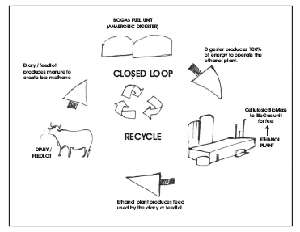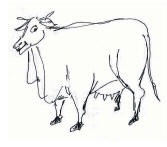<<< Previous
|
|
Next
> >>
|
| OTHER WASTES |
 click here to enlarge image |
It is not just the human waste that can be recycled and used
as a resource for farming
purposes; animal waste can do wonders too! Infact
traditionally cow dung cakes have
been used as a fuel for cooking. Cow's urine has even been
an essential part of the ritual
performances for thousands of years. For years the cow dung
has been used to line the
floors and walls because of its insect repellant properties.
In our times it is used to
produce biogas and energy.
According to the United Nations' Food and
Agricultural Organization (FAO), there are
about 1.3 billion cattle worldwide (one for
every five people), slightly more than 1 billion
sheep, around 1 billion pigs, 800 million goats
and 17 billion chickens. Between them, they produce a lot of fecal matter -- around 13 billion tons of it a year, according to various estimates. Within that matter is 55 percent to 65 percent methane, which when released into the atmosphere is bad news for us (it traps heat at 23 times the rate that carbon dioxide does) -- but when burned is another matter entirely. It gives us energy.
and 17 billion chickens. Between them, they produce a lot of fecal matter -- around 13 billion tons of it a year, according to various estimates. Within that matter is 55 percent to 65 percent methane, which when released into the atmosphere is bad news for us (it traps heat at 23 times the rate that carbon dioxide does) -- but when burned is another matter entirely. It gives us energy.
The equation :

1 pound of cowmanure [heated at 28 degrees Celsius]=1 cubic feet of biogas (enough to cook one day's meals for 4-6 people in India)
* 1 Cow's manure in 1 year converted to methane = fuel provided by 200 liters-plus of gasoline.
7,500 cattle = 1 megawatt (MW) of electricity (1MW can power the average home in the developed world), according to the University of Alberta, Canada. The university also says it would take all of the manure of 6 million cows to fulfill the needs of 1 million homes -- or about six cows per home.
Taken from Animal waste: Future energy, or just hot air? by Rachel Oliver
http://www.cnn.com/2008/WORLD/asiapcf/01/07/eco.about.manure/

1 pound of cowmanure [heated at 28 degrees Celsius]=1 cubic feet of biogas (enough to cook one day's meals for 4-6 people in India)
* 1 Cow's manure in 1 year converted to methane = fuel provided by 200 liters-plus of gasoline.
7,500 cattle = 1 megawatt (MW) of electricity (1MW can power the average home in the developed world), according to the University of Alberta, Canada. The university also says it would take all of the manure of 6 million cows to fulfill the needs of 1 million homes -- or about six cows per home.
Taken from Animal waste: Future energy, or just hot air? by Rachel Oliver
http://www.cnn.com/2008/WORLD/asiapcf/01/07/eco.about.manure/
| A Directory of Environmentally Sound Technologies for the
Integrated Management of Solid, Liquid and Hazardous Waste for
Small Island Developing States (SIDS) in the Pacific Region
Compiled
by OPUS International in conjunction with the South Pacific
Regional
Environment Programme (SPREP) and the South Pacific Applied
Geoscience Commission (SOPAC). July 2002
http://www.unep.org/depi/PDF/Directory_for_SIDS.PDF [C.eldoc1/d70d/undp1_020701zzz1B.pdf] |
| Ecological Sanitation : Revised and Enlarged Edition
StockholmEnvironment Institute, 2004 http://63.166.104.204/sei/seipubs.nsf/147c0a6246fd7421c12566030073fbb3/ 8533aa01734f988bc125703600300808/$FILE/Ecological%20Sanitation%202004.pdf |
|
|
<<< Previous
|
|
Next
> >>
|